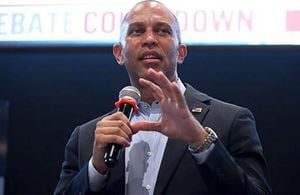Jagadish Shukla’s story begins under the dappled shade of a banyan tree in the village of Mirdha, Ballia district, Uttar Pradesh. There, as a boy, he would pray for the monsoon rains—sometimes they’d bring life, sometimes disaster. It was this uncertainty, this hope for a sign, that first planted the question in his mind: What if we could know what the weather would bring?
That question, born from the anxieties of rural India, would eventually upend the very foundations of meteorology. According to the Hindustan Times, Shukla’s path from humble beginnings to global scientific acclaim is nothing short of remarkable. After attending primary school outdoors, he went on to Banaras Hindu University, collecting degrees in physics, mathematics, geology, and geophysics. But the real leap came in 1970, when a 26-year-old Shukla landed nervously at Boston’s Logan Airport, clutching a student visa and a dream: to unlock the secrets of seasonal weather prediction at MIT.
At the time, the scientific consensus was bleak. As The Washington Post recounts, most experts, influenced by Edward Lorenz’s famed “butterfly effect,” believed weather couldn’t be predicted beyond ten days. The tiniest change—a butterfly’s wingbeat—could, in theory, send forecasts into chaos. But Shukla saw things differently. Where others focused on unpredictable “initial conditions,” he noticed that certain “boundary conditions”—like ocean temperatures, soil moisture, and snow cover—remained stable across seasons and could, perhaps, offer a foothold for prediction.
His insight would prove revolutionary. In a later interview with Science Friday, Shukla explained, “Weather prediction is about daily sequences up to 10 days. Seasonal prediction is about averaging seasonal conditions.” This subtle shift—looking for patterns in the averages, not the day-to-day noise—became his life’s work. It was the kind of simple, elegant idea that, in hindsight, seems obvious. But at the time, it was heresy.
Shukla’s breakthrough came with what he dubbed his “billion butterfly” experiment. As The Washington Post details, he and his team ran computer simulations that wildly altered initial conditions—imagine billions of Lorenz’s butterflies flapping all at once—while keeping boundary conditions fixed. The result? Daily weather was chaotic, but the seasonal averages stayed remarkably consistent. This finding, published in his landmark 1998 paper in Science, “Predictability in the Midst of Chaos,” fundamentally changed how meteorologists approached long-term forecasting.
James Kinter, current director of the Center for Ocean-Land-Atmosphere Studies, which Shukla founded, summed it up for The Washington Post: “The result was stark… The ’98 paper was able to synthesize all that.”
Shukla’s contributions didn’t stop there. He played a central role in the Global Weather Experiment, a project that, according to the Kashmir Times, “revolutionized weather forecasting” by harnessing supercomputers to analyze vast atmospheric datasets. His work helped lay the groundwork for the sophisticated models that now underpin everything from hurricane warnings to drought forecasts.
Yet Shukla’s journey wasn’t just about scientific puzzles. It was also about grappling with the world’s most urgent problems. Initially cautious about claims of human-induced climate change, his scientific rigor demanded evidence. In 2004, he joined the UN’s Intergovernmental Panel on Climate Change (IPCC), where, after reviewing the mountains of data and global climate models, his skepticism gave way to alarm. As reported by The Washington Post, he moved “from ambivalence to alarm.”
Shukla became a lead author of the IPCC’s Fourth Assessment Report in 2007, the document that famously declared the “warming of the climate system is unequivocal” and pinpointed “discernible human influences.” For this work, the IPCC and Al Gore were jointly awarded the Nobel Peace Prize. NASA confirms that Shukla shared in this historic recognition. The Nobel Prize organization’s records cement his place in climate science history.
Reflecting on this moment, Shukla told The Washington Post: “I cannot accept something simply on faith and belief. The reason 2007 got the Peace Prize was because it was the first time our model said, ‘Oh, it’s now beyond the uncertainty.’”
But with fame came controversy. In 2015, as fossil fuel companies ramped up efforts to cast doubt on climate science, Shukla wrote to President Obama, urging an investigation into energy companies accused of misleading the public. The backlash was swift. House Republicans accused Shukla’s nonprofit of partisan activity and launched a punishing investigation. The Washington Post describes this as one of the most “cruel and chaotic” periods of his life, filled with sleepless nights and relentless demands for documentation. Ultimately, the investigation found nothing amiss.
Unbowed, Shukla stood firm: “It’s a small price to pay to defend the integrity of climate science. If we don’t defend it, who will?” he told The Washington Post.
His scientific achievements have been recognized with some of the world’s highest honors. The World Meteorological Organization awarded him the International Meteorological Organization Prize in 2007, which multiple sources call “the highest scientific recognition in the world” for meteorology. In 2012, India bestowed upon him the Padma Shri Award.
Now, at 81, Shukla continues his research from his office in Bethesda, Maryland, satellite maps of India adorning the walls. According to The Washington Post, he still seeks “predictable components in a chaotic system.” His recent memoir, “A Billion Butterflies: A Life in Climate and Chaos Theory,” chronicles this extraordinary journey from rural India to the heights of global scientific leadership. Murali K. Menon of the Hindustan Times describes the memoir as one that “blends reminiscences, science history, and urgent critique.”
But Shukla’s story is more than a tale of individual brilliance. It’s a powerful argument for the value of international students in American science. As the Trump administration has rolled out increased vetting and visa restrictions—policies that have led to the revocation of hundreds of student visas and cast a chill over U.S. universities—Shukla’s journey stands as a reminder of what’s at stake. His contributions, from pioneering seasonal forecasting to advancing climate science, all began with a single student visa and a young man’s determination to answer a childhood question.
As The Washington Post notes, Shukla’s work has founded research institutions, trained generations of American scientists, and helped cement the United States’ position as a leader in climate science. The World Meteorological Organization recognized his impact in 2007, and his legacy continues to inspire new generations of researchers.
In an era where the doors to international talent are being closed, Shukla’s life is a testament to the fact that America’s scientific greatness has always been built on welcoming the world’s brightest minds—those who arrive with questions forged by their unique experiences and a drive to make a difference.
From the shade of a banyan tree in Mirdha to a Nobel Prize in climate science, Jagadish Shukla’s journey is a living reminder that the most profound breakthroughs often begin with a simple question and the courage to pursue it across continents.



